I love my crepe myrtle trees with their moderately dense, dark green oval leaves, and showy pink flowers. I feel like these medium-sized trees bring pure joy to my backyard.
Since I always try to ensure I follow the best care practices when planting, watering, and fertilizing my crepe myrtles, I was very shocked to find that the leaves had turned red after I was on vacation for a few weeks.
I couldn’t wait to find answers so I could remedy the situation — ASAP.
If your crepe myrtle tree also has red leaves and you want to know what’s up, I’ve got all the answers (and solutions) for you.
Table of Contents
Why Are My Crepe Myrtle Leaves Turning Red?
Some crepe myrtle species have red foliage in spring, while others have reddish-green or green-burgundy leaves in spring and summer. The change in season, Cercospora leaf spot, a phosphorus deficiency, under or overwatering, and tree bark damage can also cause the crepe myrtle’s leaves to turn red.
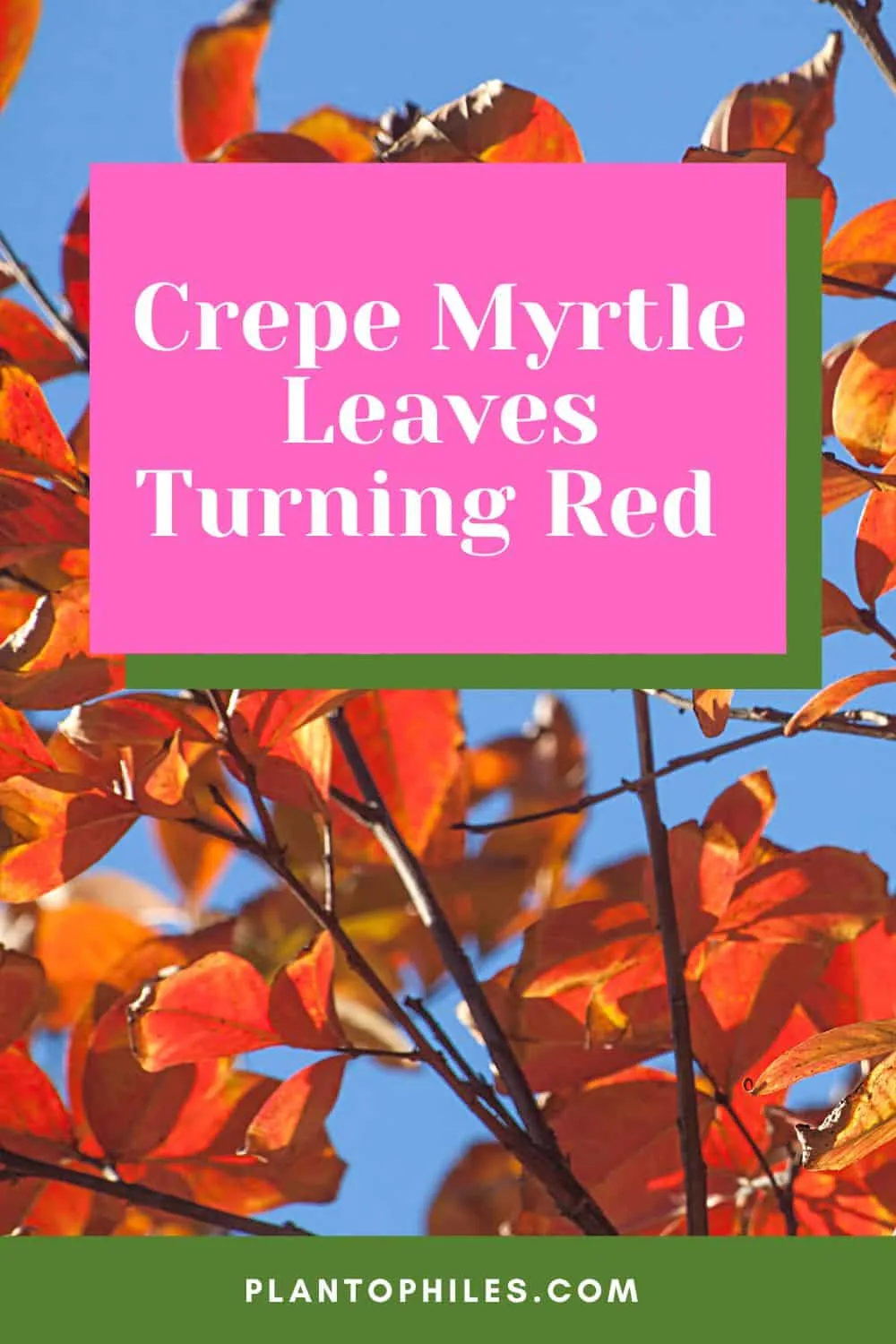
5 Reasons Why Crepe Myrtle Leaves Turn Red
Crepe myrtle and crape myrtle (Lagerstroemia) is the same tree or shrub. Californians are more likely to use the “crape myrtle” spelling, while those of us in the South prefer “crepe myrtle.”
I just wanted to share this in case you are wondering whether crepe and crape myrtles are different trees and if you are reading the right information.
Without further ado, here are the most common reasons the leaves on a crepe myrtle tree can turn red:
Cause 1: The Variety
This one “cause” is nothing to worry about. It’s simply nature.
Your crepe myrtle shrub could have red foliage at the start of spring; however, the leaves may darken to green during summer.
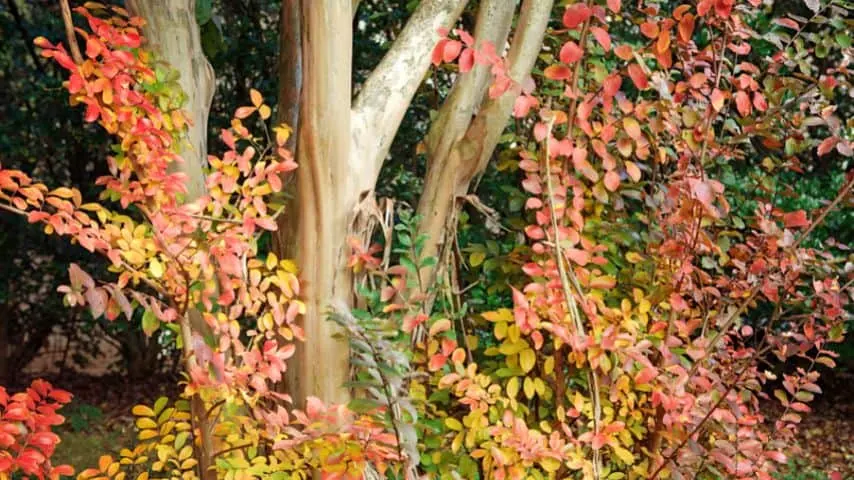
There are also varieties of crepe myrtles like the Tuscarora crepe myrtle and the Dynamite crepe myrtle that have stunning red leaves in early spring.
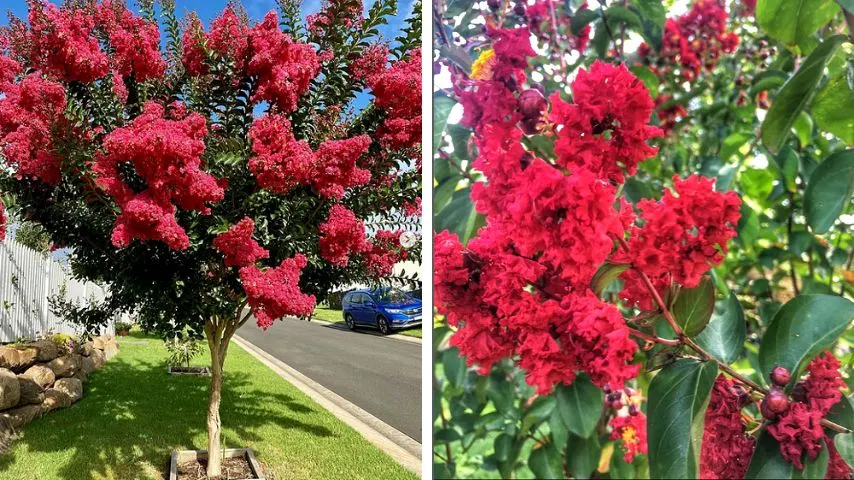
With longer days and the weather warming up, the leaves turn dark green.
Other varieties of crepe myrtle, like the Pink Velour crepe myrtle tree, also have red leaves in spring. However, the foliage remains red for several weeks. This tree’s leaves are a reddish dark green during the growing season.
Even the Burgundy Cotton crepe myrtle has green-burgundy leaves during summer.
Cause 2: Change in Seasons
Aside from the variety of crepe myrtle trees, the change in season also causes the leaves to change color. Many crepe myrtles turn orange or yellow in fall, but a few crepe myrtle varieties have a rich red (and possibly orange and yellow) foliage when the weather cools in fall.
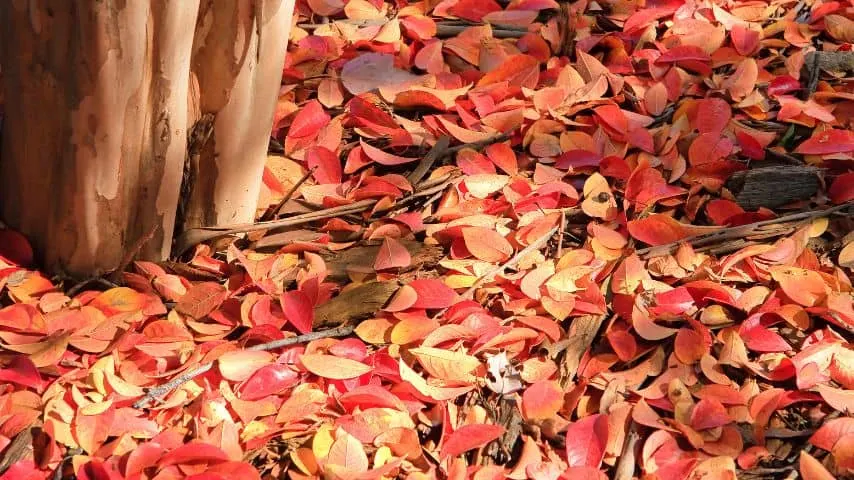
Here are some of the varieties that feature red leaves during fall:
- Catawba crepe myrtle
- Muskogee crepe myrtle
- Natchez crepe myrtle
- Sioux crepe myrtle
- Twilight crepe myrtle
- Pocomoke crepe myrtle
- Queen’s crepe myrtle
Cause 3: Fungal Infection
If it isn’t a change in season or the type of crepe myrtle you have, it’s likely that your tree has a fungal infection. Most specifically, it’s Cercospora leaf spot.
Cercospora leaf spot is caused by a fungus in the Cercospora species. This fungal infection typically occurs when water drops sit on the leaves of a plant, shrub, or tree during humid and hot conditions with little to no airflow.
When your crepe myrtle is infected, yellow or purple spots that are ¼ of an inch in diameter will appear on the leaves’ upper surface. White-gray sporulation appears on the leaves’ lower surface.
Depending on the variety of your crepe myrtle tree, the leaves will start turning red, orange, yellow, or brown. Eventually, the leaves will fall off and your tree won’t bloom.
How to Fix Cercospora Leaf Spot
Prevention is best, so ensure there is plenty of airflow between the leaves and branches, and don’t let water splash onto the foliage when you water.
If your crepe myrtle is already infected, treat the shrub or tree with a copper-based fungicide. You can also make an antifungal spray with 1.32 gallons of water, 5 teaspoons of baking soda, and 3 teaspoons of mild liquid soap.
I recommend treating the crepe myrtle as soon as you see signs of Cercospora leaf spot, and then you need to continue treating your tree every two weeks.
If leaves have been infected, remove them and safely dispose of them so the fungal spores can’t spread to other crepe myrtles, plants, or trees in your garden.
Cause 4: Phosphorus Deficiency
If the leaves on your crepe myrtle are turning red, it could be that your soil isn’t phosphorus-rich.
You may also see that the shrub’s growth is stunted to some extent and blooming will be a lot less than normal.
How to Fix a Phosphorus Deficiency
Choose a slow-release, all-purpose shrub fertilizer, and apply this to your crepe myrtle.
Adding bone meal for an instant dose of phosphorus.
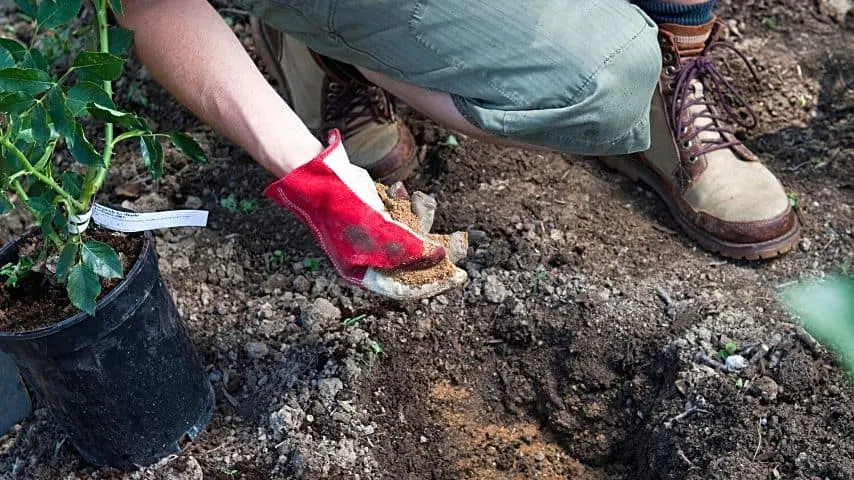
Cause 5: Environmental Issues
Various environmental issues can cause your crepe myrtles to turn red.
For example, either overwatering or underwatering can turn the leaves red. The reason is that improper watering methods disrupt the movement of phosphorus.
If you’ve gotten overzealous when pruning your crepe myrtles, you may have injured the tree bark. The result then is leaves turn purple or red.
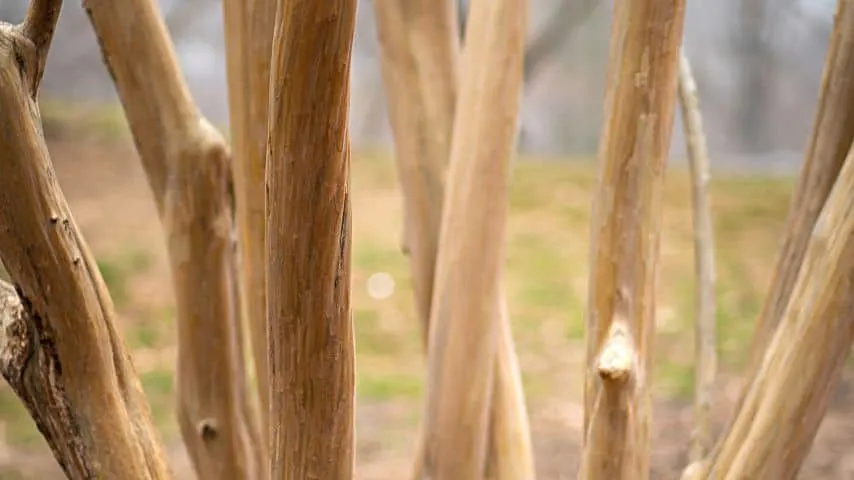
How to Fix Environmental Issues
The easiest is to ensure you follow all the best practices when caring for your crepe myrtles:
- Full sun with minimal shade
- Well-draining soil like clay, silt, or loam
- Use of slightly acidic soil that’s nutrient-rich as well
- Grow zones include USDA plant hardiness zones 7 to 9
- Ensure there’s plenty of airflow
- Fertilize when needed
- Give at least one inch of water weekly, and slightly more when the weather’s hot
Frequently Asked Questions about Crepe Myrtle Leaves Turning Red
Do crepe myrtles have red leaves?
Crepe myrtles can have red leaves during the fall, but the leaves can also be orange or yellow. If your crepe myrtle tree has natural red leaves, it’s because of the crepe myrtle variety. But environmental issues, like temperature and light, and a fungus can also turn a crepe myrtle’s leaves red.
Why would a crepe myrtle change color?
There are various reasons why a crepe myrtle tree can change color. These reasons include changes in water, temperature, sunlight, soil quality, and chlorophyll levels. A fungal infection, like Cercospora leaf spots, also results in leaf color changes.
Do crepe myrtle leaves change color when the seasons change?
Technically, crepe myrtle leaves don’t change color from summer to fall. When the leaves “change” color, they simply reveal other colors that are present all along. During shorter and cooler days, like during fall, the leaves produce less chlorophyll, so the other leaf pigments can be seen.
Conclusion on Crepe Myrtle Leaves Turning Red
The reasons for crepe myrtle leaves turn red are:
- Red foliage due to spring
- Cercospora leaf spot
- Phosphorus deficiency
- Under- or overwatering
- Tree bark damage

Daniel has been a plant enthusiast for over 20 years. He owns hundreds of houseplants and prepares for the chili growing seasons yearly with great anticipation. His favorite plants are plant species in the Araceae family, such as Monstera, Philodendron, and Anthurium. He also loves gardening and is growing hot peppers, tomatoes, and many more vegetables.


